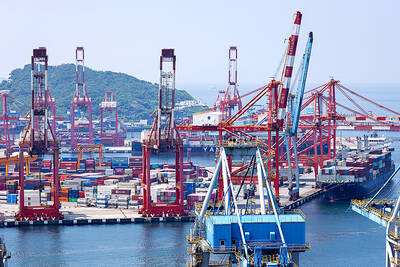AU Optronics Corp (AUO, 友達光電) and LG Display Co (LGD) might consider investing in low-cost G10.5 fabs to produce 65-inch and 75-inch LCD TV panels to capitalize on the increasing demand for big-screen TVs, IHS Markit said.
That would also elevate the competition in the global LCD panel industry to a new level, as only Chinese flat-panel makers are spending lavish funds on building G10.5 fabs, the market researcher said on Thursday.
FOUR NEW PLANTS
Four G10.5 plants are expected to enter operation in 2019 or 2020 in China, including those owned by BOE Technology Group (京東方) and China Star Optoelectronics Technology Co (華星光電), IHS Markit analyst David Hsieh (謝勤益) told reporters on the sidelines of an annual display forum in Taipei.
By the end of 2019, China is expected to control 45 percent of the world’s flat-panel market, while Taiwan and South Korea will have a 23 percent and 26 percent share respectively, the research house said.
“Chinese companies are targeting jumbo-size 65-inch and 75-inch TV panels,” Hsieh said. “However, the investment and consumption of resources are enormous, while technological barriers are high.”
A G10.5 production line would cost US$5.8 billion and would require 445 hectares of land, Hsieh said.
In comparison, a low-cost G10.5 production line would cost only about US$3 billion, or half of the amount required for a G10.5 line, he said.
For cost-sensitive companies like AUO, it will be an optimal choice, Hsieh said.
“AUO and LGD are considering building low-cost G10.5 lines to expand capacity, as demand for 65-inch panels is high,” he said.
AUO, Innolux Corp (群創), LG Display and Samsung Electronics Co are the world’s major suppliers of 65-inch TV panels, according to IHS Markit.
Hsieh said TV panel prices are to slide next quarter, snapping the longest streak of price increases in the industry’s history.
TV set makers have stockpiled large inventories due to concerns of supply constraints, he said.
TIGHT SUPPLY
Prices for most TV panels this month are generally flat from last month, according to IHS Markit.
Prices for 50-inch and 65-inch TV panels rose only between US$2 and US$5 per unit due to tight supply, it said.
However, Hsieh said he does not expect panel prices to collapse any time soon, as demand will outstrip supply by 5 percent.
“Supply will continue to be tight this year,” he said.
IHS Markit said it expects panel prices to remain stable this quarter, and the price trend in the second half of the year would depend on inventory digestion and shipments, as new capacity additions are not expected to be significant.

Nvidia Corp chief executive officer Jensen Huang (黃仁勳) on Monday introduced the company’s latest supercomputer platform, featuring six new chips made by Taiwan Semiconductor Manufacturing Co (TSMC, 台積電), saying that it is now “in full production.” “If Vera Rubin is going to be in time for this year, it must be in production by now, and so, today I can tell you that Vera Rubin is in full production,” Huang said during his keynote speech at CES in Las Vegas. The rollout of six concurrent chips for Vera Rubin — the company’s next-generation artificial intelligence (AI) computing platform — marks a strategic

REVENUE PERFORMANCE: Cloud and network products, and electronic components saw strong increases, while smart consumer electronics and computing products fell Hon Hai Precision Industry Co (鴻海精密) yesterday posted 26.51 percent quarterly growth in revenue for last quarter to NT$2.6 trillion (US$82.44 billion), the strongest on record for the period and above expectations, but the company forecast a slight revenue dip this quarter due to seasonal factors. On an annual basis, revenue last quarter grew 22.07 percent, the company said. Analysts on average estimated about NT$2.4 trillion increase. Hon Hai, which assembles servers for Nvidia Corp and iPhones for Apple Inc, is expanding its capacity in the US, adding artificial intelligence (AI) server production in Wisconsin and Texas, where it operates established campuses. This

Garment maker Makalot Industrial Co (聚陽) yesterday reported lower-than-expected fourth-quarter revenue of NT$7.93 billion (US$251.44 million), down 9.48 percent from NT$8.76 billion a year earlier. On a quarterly basis, revenue fell 10.83 percent from NT$8.89 billion, company data showed. The figure was also lower than market expectations of NT$8.05 billion, according to data compiled by Yuanta Securities Investment and Consulting Co (元大投顧), which had projected NT$8.22 billion. Makalot’s revenue this quarter would likely increase by a mid-teens percentage as the industry is entering its high season, Yuanta said. Overall, Makalot’s revenue last year totaled NT$34.43 billion, down 3.08 percent from its record NT$35.52

PRECEDENTED TIMES: In news that surely does not shock, AI and tech exports drove a banner for exports last year as Taiwan’s economic growth experienced a flood tide Taiwan’s exports delivered a blockbuster finish to last year with last month’s shipments rising at the second-highest pace on record as demand for artificial intelligence (AI) hardware and advanced computing remained strong, the Ministry of Finance said yesterday. Exports surged 43.4 percent from a year earlier to US$62.48 billion last month, extending growth to 26 consecutive months. Imports climbed 14.9 percent to US$43.04 billion, the second-highest monthly level historically, resulting in a trade surplus of US$19.43 billion — more than double that of the year before. Department of Statistics Director-General Beatrice Tsai (蔡美娜) described the performance as “surprisingly outstanding,” forecasting export growth